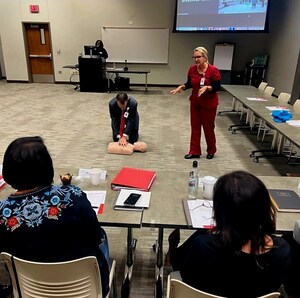Study Highlights:
-- The less physically active you are, the more your blood pressure rises in response to a high-salt diet.
-- Following a low-salt diet may be particularly important in lowering blood pressure among sedentary people.
ATLANTA, March 23, 2011 /PRNewswire-USNewswire/ -- The more physically active you are, the less your blood pressure rises in response to a high-salt diet, researchers reported at the American Heart Association's Nutrition, Physical Activity and Metabolism/Cardiovascular Disease Epidemiology and Prevention 2011 Scientific Sessions.
(Logo: http://photos.prnewswire.com/prnh/20100222/AHSALOGO)
"Patients should be advised to increase their physical activity and eat less sodium," said Casey M. Rebholz, M.P.H., lead author of the study and a medical student at the Tulane School of Medicine and doctoral student at the Tulane University School of Public Health & Tropical Medicine in New Orleans. "Restricting sodium is particularly important in lowering blood pressure among more sedentary people."
Investigators compared study participants' blood pressure on two one-week diets, one low in sodium (3,000 mg/day) and the other high in sodium (18,000 mg/day).
The American Heart Association recommends consuming less than 1,500 mg/day of sodium.
If a person's average systolic blood pressure (the top number in the reading, measured when the heart is contracting) increased 5 percent or more from the low-sodium to the high-sodium regimen, the researchers labeled them as high salt-sensitive.
Based on physical activity questionnaires, researchers divided participants into four groups ranging from very active to quite sedentary.
The average increases in systolic blood pressure after switching from low to high sodium, adjusted for age and gender, were:
- 5.27 mm Hg in the least active group
- 5.07 mm Hg in the next-to-lowest activity group
- 4.93 mm Hg in the next-to-highest activity group
- 3.88 mm Hg in the most active group
Compared with the sedentary group, the odds of being salt-sensitive, adjusted for age and gender, fell:
- 10 percent in the next-to-lowest activity group
- 17 percent in the next-to-highest activity group
- 38 percent in the most active group
"In all the analyses we found a dose-response relationship with the more activity, the better," Rebholz said.
The participants were 1,906 Han Chinese adults (average age 38) in the Genetic Epidemiology Network of Salt Sensitivity (GenSalt), a large project to identify genetic and environmental factors contributing to salt sensitivity. Siblings and their parents were invited to become involved in GenSalt if at least one sibling had pre-hypertension (blood pressure between 120/80 and 139/89 mm Hg) or stage-1 hypertension (between 140/90 and 159/99 mm Hg). No one was on blood pressure medication during the study.
The GenSalt project is located in rural China because the homogeneous population makes it more likely that genes influential to blood pressure control will be identified.
"The study needs to be repeated, but I suspect that the relationship between physical activity and salt-sensitivity will apply to other populations," Rebholz said.
Co-authors are: Dongfeng Gu, Ph.D.; Jing Chen, M.D., M.S.; Jian-feng Huang, M.D.; Jie Cao, M.D., M.S.; Ji-chun Chen, M.D., M.S.; Jianxin Li, M.D.; Fanghong Lu, M.D.; Jianjun Mu, M.D.; Jixiang Ma, M.D.; Dongsheng Hu, M.D., M.S.; Xu Ji, M.D.; Lydia A. Bazzano, M.D., Ph.D.; Depei Liu, M.D., Ph.D.; and Jiang He, M.D., Ph.D.
Author disclosures and sources of funding are on the abstract.
Note: Actual presentation time is 5 p.m. ET, Wednesday, March 23, 2011.
Statements and conclusions of study authors that are presented at American Heart Association scientific meetings are solely those of the study authors and do not necessarily reflect the association's policy or position. The association makes no representation or guarantee as to their accuracy or reliability. The association receives funding primarily from individuals; foundations and corporations (including pharmaceutical, device manufacturers and other companies) also make donations and fund specific association programs and events. The association has strict policies to prevent these relationships from influencing science content. Revenues from pharmaceutical and device corporations are available at www.americanheart.org/corporatefunding.
NR11 – 1045 (EPI/NPAM/Rebholz)
Additional resources:
- Multimedia resources (animation, audio, video and images) are available in our newsroom at EPI/NPAM 2011 - Multimedia. Downloadable audio and/or video interview clips with AHA experts offering perspective on news releases will be added prior to embargo for use after embargo.
CONTACT:
Cathy Lewis (214) 706-1324; [email protected]
Darcy Spitz (212) 878-5940; [email protected]
Maggie Francis (214) 706-1382; [email protected]
SOURCE American Heart Association
WANT YOUR COMPANY'S NEWS FEATURED ON PRNEWSWIRE.COM?
Newsrooms &
Influencers
Digital Media
Outlets
Journalists
Opted In






Share this article